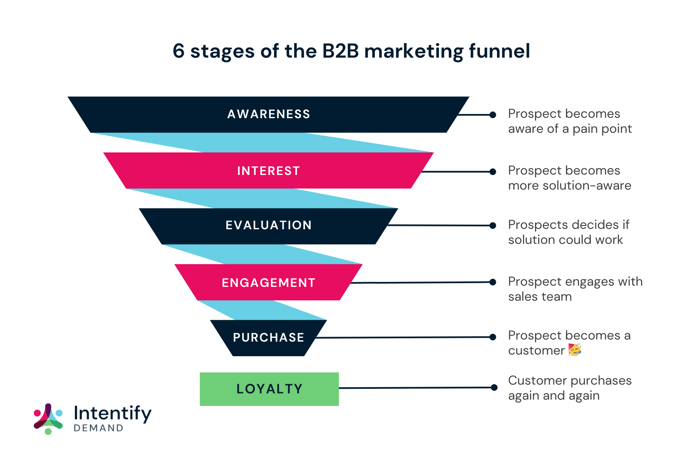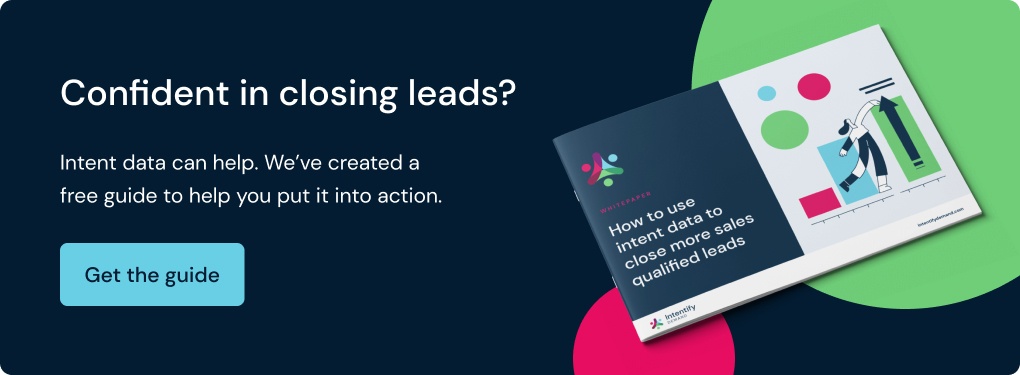Read time: 7 minutes
You know the story: your product is the perfect fit for your lead, but it's not the right time. Or you've had several promising touchpoints, but the handshake never comes. Somehow, your winning approach to converting new leads is running out of steam.
These are all signs your B2B marketing funnel needs help.
Knowing the signs of a lead drought and recognising them early is essential to fixing your funnel and preventing bigger issues from arising further down the line. Left unchecked, things can quickly spiral out of control, costing the business potential customers and damaging your sales pipeline.
So now's the time to step back and ask: is my B2B marketing funnel still working as it should?
What does the B2B marketing funnel look like?
While every B2B funnel is unique, they each include the same six stages and it's important for marketers to understand each one so you can craft relevant campaigns with the right kind of content that potential customers want to see.
- Awareness stage: this is when potential customers become aware of a pain point or need. This may happen naturally, but could also be as a result of your brand awareness or email marketing campaigns.
- Interest stage: this is when a prospective customer will move into a more solution-aware phase as they begin to look into which solutions will solve their pain point.
- Evaluation stage: this is the stage where you can start to demonstrate how your product is the best solution. It's key to focus on removing fears or concerns about implementation, building trust and earning credibility.
- Engagement stage: this is when a prospect will engage with your sales team and requires a sold lead qualification process to ensure they're not going to drain your sales team's resources.
- Purchase stage: this is when everything aligns and your prospect becomes a paying customer.
- Loyalty stage: the customer journey doesn't just end at a purchase. Post-purchase relationships are critical in maintaining a healthy sales pipeline and keeping customers happy.

4 warning signs to look out for in your B2B marketing funnel
We all know a healthy funnel means good things for the sales team. The pressure to ensure everything is running smoothly often means things get missed. To keep Sales happy, and your marketing funnel working as it should, here are four warning signs to look out for:
1. You're not receiving many inbound leads
This can happen for a variety of reasons. If your website traffic is low, then your SEO strategy might need improvement. If your social engagement is low, then your content isn't resonating with your target audience. A lot of this comes down to the fact that you don't have enough valuable information about your target audience. Ultimately, not capturing enough qualified leads means you don't have anyone to convert into revenue.
2. The leads you do have are low (or no) intent
Not all leads are equal. Some are more likely to become a customer than others. Understanding purchase intent helps you focus on the leads that are in the market for a new solution. Without multiple touchpoints and advanced analytics though, it's hard to classify leads by intent.
3. You don't have insight into the behaviours and needs of your leads
You know who your target audience is, but do you understand their needs, their priorities, and how they operate? Having this knowledge is essential to make your B2B marketing funnel more efficient. It also helps you refine your approach to focus on tactics that resonate with them.
4. Sales calls go nowhere
You may have a good number of leads, but they remain stuck at the same stage of the funnel forever. Understanding your lead's intent is essential to improve the accuracy of your targeting. Being familiar with their journey is how you can establish meaningful connections.
How to end the lead drought: 5 tips to improve your marketing funnel
If you've spotted one (or more) of our warning signs, don't panic. Identifying the issue is just the first step, the next is to fix it, and we've got a few expert tips here:
Target the right leads
It almost goes without saying, but if you're not targeting the right leads, your campaign (and budget) is simply going to waste.
Take the time to review your ideal customer profile (ICP) and match this to your buyer personas to better understand who it is you're targeting. Once you've been able to do this, it should give you a clearer idea of exactly who you're targeting. Then you can start afresh, targeting the right leads on the right platforms and with the right content.
Make your funnel as simple as possible
Every company suffers from bottlenecks in one form or another. But the marketing funnel is a key place where you really need to focus on eliminating them. Whether it's your demo sign-up or product payment, creating a simpler customer journey will go a long way in improving your conversion rates.
Map out your current touchpoints and expected customer route, then review each step and ask yourself how necessary it is, and whether it can be made simpler. Assessing the full customer experience in this way will ensure nothing is left out.
Collect the right data about your current processes
It's impossible to have insight into what's going wrong without having the right data at hand. Create a list of metrics you want to see and then work out how you can access them. Some you may already have but may be stored in a different platform, while others may need additional set-up or configuration.
Blind spots in your funnel could be hiding a bigger issue that is impacting your conversion rates, so collecting as much data as you can in real-time is a great way to diagnose what's going wrong and then fix it.
Adjust your campaign strategies
There's no such thing as 'set and forget' in marketing. Everything should be monitored and optimised based on performance to obtain the best results. Nothing in life is static and marketing shouldn't be either.
Take the time to regularly review your ongoing campaigns and then make adjustments based on performance. Not only is this good practice to ensure marketing efforts don't go to waste, but it can play a big part in keeping your marketing funnel full and healthy.
Create better, more relevant content
Content is the lifeblood of any successful marketing funnel; without it, you'll struggle to generate and convert leads. But it's not enough to pump out generic blog posts and hope they convert. Marketing teams need a more careful and considered approach to the content they create if they want their funnel to work.
This means understanding the different stages of the funnel outlined above and creating content that appeals to each one. Brands need to be able to build trust, allay fears, address concerns, and demonstrate their unique differentiators through the content they share on their marketing channels, whether that's a company website, via email marketing or on social platforms.
All droughts come to an end
Now that you've recognised your B2B marketing funnel isn't working as it should and why, what are the next steps?
A lot of the pain points we covered have one thing in common: a lack of understanding of purchase intent.
Recommended reading: Purchase intent: How to find best-fit lead opportunities
A recent study by Ehrenberg-Bass found only 5% of B2B buyers are ever in the market for a new product or service in a given quarter. Being able to identify and connect with that 5% is critical to sales success. Which leads to the question: how can you identify them?
Intent data looks at online behaviour and profiling information to spot those leads. We work with our clients to refine our intent data and find the leads that are in-market.
This kind of accurate targeting fills your pipeline with meaningful opportunities and improves your conversion rate. In other words, intent-only data turns your lead drought into an opportunity oasis.
For advice on how to take those leads and nurture them into revenue, just reach out.
This article was updated 12th January, 2024




